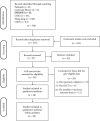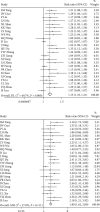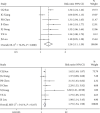A Meta-analysis of Xiaoyin Granules Combined with Acitretin Capsule in the Treatment of Psoriasis Vulgaris
- PMID: 35936361
- PMCID: PMC9348960
- DOI: 10.1155/2022/7360975
A Meta-analysis of Xiaoyin Granules Combined with Acitretin Capsule in the Treatment of Psoriasis Vulgaris
Retraction in
-
Retracted: A Meta-analysis of Xiaoyin Granules Combined with Acitretin Capsule in the Treatment of Psoriasis Vulgaris.Comput Math Methods Med. 2023 Dec 6;2023:9785947. doi: 10.1155/2023/9785947. eCollection 2023. Comput Math Methods Med. 2023. PMID: 38094374 Free PMC article.
Abstract
Background: Psoriasis is a chronic noncommunicable dermatological condition, and psoriasis vulgaris is the most common phenotype. Acitretin is the most widely used systemic retinoid in the treatment of psoriasis. This review evaluates the clinical therapeutic effects of Xiaoyin granule, a Chinese herbal medicine, combined with acitretin capsule in the treatment of psoriasis vulgaris.
Methods: Six databases including PubMed, Cochrane Library, EMBASE, China National Knowledge Infrastructure (CNKI), Wan Fang, and China Biology Medicine disc (CBM) were searched for published studies on Xiaoyin granule and/or acitretin capsule in psoriasis vulgaris. The Cochrane Collaboration risk-of-bias instrument was used to assess the quality of the included RCTs. STATA 14.0 was used to conduct the statistical analysis.
Results: Twenty-eight trials with 3281 patients were included in this meta-analysis. The results of this study show that the combined treatment of Xiaoyin granule and acitretin capsule could improve the total effective rate (TER) and cure rate (CR) when compared with acitretin capsule (TER: RR = 1.15, 95% CI (1.10, 1.21); CR: RR = 1.8, 95% CI (1.62, 2.00)) or Xiaoyin granule (TER: RR = 1.24, 95% CI (1.11, 1.39); CR: RR = 1.75, 95% CI (1.54, 1.98)) alone. The combined therapy could decrease the PASI score (mean difference = -1.45, 95% CI (-2.09, -0.80)) and inhibit inflammation (IL-10: mean difference = 1.16, 95% CI (0.94, 1.38); IL-17: mean difference = -2.06, 95% CI (-2.60, -1.51)) in psoriasis vulgaris patients.
Conclusions: The combination of Xiaoyin granule and acitretin capsules could be a novel therapeutic strategy in the treatment of psoriasis vulgaris. However, the quality of trials in this study limited the conclusion, and more high-quality RCTs are needed for further evaluation.
Copyright © 2022 Aiai Geng et al.
Conflict of interest statement
The authors declare that they have no conflict of interest.
Figures








Similar articles
-
Retracted: A Meta-analysis of Xiaoyin Granules Combined with Acitretin Capsule in the Treatment of Psoriasis Vulgaris.Comput Math Methods Med. 2023 Dec 6;2023:9785947. doi: 10.1155/2023/9785947. eCollection 2023. Comput Math Methods Med. 2023. PMID: 38094374 Free PMC article.
-
Efficacy and safety of external application of Chinese herbal medicine for psoriasis vulgaris: a systematic review of randomized controlled trials.J Tradit Chin Med. 2022 Aug;42(4):493-504. doi: 10.19852/j.cnki.jtcm.20220617.001. J Tradit Chin Med. 2022. PMID: 35848965 Free PMC article.
-
Xiyanping injection combined with acitretin for psoriasis vulgaris: A systematic review and meta-analysis.Front Pharmacol. 2022 Sep 6;13:971715. doi: 10.3389/fphar.2022.971715. eCollection 2022. Front Pharmacol. 2022. PMID: 36147319 Free PMC article.
-
Effect of Chinese herbal medicine combined with acitretin capsule in treating psoriasis of blood-heat syndrome type.Chin J Integr Med. 2009 Apr;15(2):141-4. doi: 10.1007/s11655-009-0145-5. Epub 2009 Apr 29. Chin J Integr Med. 2009. PMID: 19407953 Clinical Trial.
-
Reconstruction Algorithm-Based Computed Tomography Image Feature for Evaluating the Effect of Internal Administration and Medicated Bath of Liangxue Xiaoyin Decoction on Psoriasis Vulgaris.Comput Math Methods Med. 2022 Mar 7;2022:7638507. doi: 10.1155/2022/7638507. eCollection 2022. Comput Math Methods Med. 2022. PMID: 35295203 Free PMC article. Clinical Trial.
Cited by
-
Retracted: A Meta-analysis of Xiaoyin Granules Combined with Acitretin Capsule in the Treatment of Psoriasis Vulgaris.Comput Math Methods Med. 2023 Dec 6;2023:9785947. doi: 10.1155/2023/9785947. eCollection 2023. Comput Math Methods Med. 2023. PMID: 38094374 Free PMC article.
References
Publication types
MeSH terms
Substances
LinkOut - more resources
Full Text Sources
Medical

